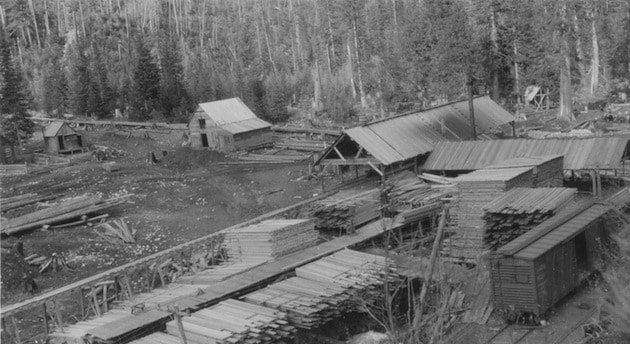Smelters blossomed in the Boundary District after the opening of the railway in order to process the largely-copper ores from various sources. The first smelter (Granby) opened at Grand Forks in August 1900, followed by the Greenwood smelter (1901), and the Dominion Copper smelter at Boundary Falls (1903). The largest ore deposits were around and underneath the city of Phoenix.
There were also productive mines in the high country closer to Farron summit: in the Burnt Basin above the railway to the west, and on the Bonanza plateau to the east. In autumn of 1901 the government funded the construction of a wagon road from the railway at Bonanza Siding to the mine workings located on the flanks of Grenville Mountain, between the headwaters of Bonanza, Orion, and Iron creeks. What became known as the Norway Mountain Road was completed on November 5:
“The road cost the government about $6,000 and opens to transportation a mining area of considerable importance. Now that it is finished it is anticipated that shipments within a short time be commenced from the Cascade and the Rossland-Bonanza mines, both of which have considerable ore in their dumps.” — Nelson Miner, Nov. 5, 1901
The Inland Empire became the dominant operation, with a townsite that included several buildings for housing workers, a recreation hall, and a boiler house. A 30 hp hoisting engine serviced a vertical shaft. A sawmill at the site produced the lumber for the buildings as well as for the mining operations. A 10-stamp mill was established nearby, producing ore concentrates that were shipped to the Trail and Grand Forks smelters. The ore yielded gold, silver, and copper.
The recreation hall took on another function in 1924 when the so-called Paulson School opened in it. It closed the following year as the mining operation was curtailed and workers moved away. The Bonanza area has a special interest for me, as over the years I developed a network of cross country ski trails, with the help of many friends, in what became known as the 1,476 hectare Bonanza Recreation Area. Old cabins and remnants of the mine workings add a historic flavour to the sunny location with exceptional views.
Logging camps flourished along the railway, which provided transportation for the mechanical parts of the mill during set-up, as well as a connection to the market. In the summer of 1924 Bilson Merry set up a sawmill south of Farron. McRae Creek was dammed to produce a mill pond, into which logs were sent along a steeply-inclined dry flume. The mill was run by a boiler and produced dimension lumber as well as cedar poles under contract with West Kootenay Power and Light Company. Suitable logs were also sent to the Eddy match-block factory in Nelson, for processing prior to shipment to the main plant at Hull, Quebec. CPR put in a siding, which took on the name of Merry Siding.
Two dwellings were constructed: one for Bilson and Eva (nee Mitchell) and their growing family; and another one that served as a residence for the Popoffs. John Popoff was mill foreman and sawyer. The two families lived at the site year around, and other workers joined them as required. Cut logs were skidded to the flume by horses or hauled by home-made wagons with solid wooden wheels. That technique was most likely introduced by the Doukhobors, their main labour force.
The family was awakened just after midnight on Oct. 29 by the train explosion which killed Doukhobor leader Peter (Lordly) Verigin and ten others. The blast, which remains unsolved, was only a kilometre to the north of their operation. The children, as they grew older, would trek to the site and look for relics such as broken dishes.
A telephone connected them to the outer world. They were able to call the Paulson grocery store for their weekly order of goods. The Wiebes filled their order and had it sent to Merry Siding by speeder. Hunting, of course, provided fresh meat, and the forest offered other fare such as mushrooms and berries. The Popoffs taught them to seek out other useful native plants such as wild celery and onions.
Around 1930 the mill was dismantled and shipped to Sheep Creek for the next operation. The abandoned mill site gradually reverted to nature, but is easily found as the trail-head of the Mount Gladstone Trail is located there. A little digging will expose old sawdust.
The author wishes to thank Paula Nocente, from Issaquah, Washington, for sharing her story and image bank of the Merry sawmill.
Walter Volovsek’s website can be found at trailsintime.org
Previous installments in this series
Lilette Mahon: A mentor’s gift
Edward Mahon: Searching for a legacy
Edward Mahon: A stimulating childhood
Intrigues: Castlegar’s lacklustre childhood
Perceptions: Adrift on the River of Life
